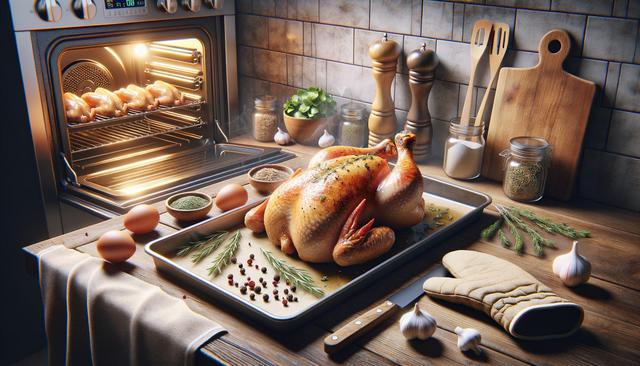Choosing the Right Cut of Chicken
Before you start baking, it’s important to select the right cut of chicken for your meal. Different cuts offer different textures and flavors, and some are better suited for baking than others. Bone-in, skin-on pieces like thighs and drumsticks retain moisture well and develop a crispy skin when baked. Boneless, skinless breasts are leaner and cook faster, but they can dry out if not monitored closely. Consider your preference and cooking time when making your choice.
Here are a few common cuts that are ideal for baking:
- Chicken thighs – juicy and flavorful, with a forgiving cook time
- Chicken drumsticks – easy to portion and kid-friendly
- Chicken breasts – lean and versatile for various seasoning options
- Whole chicken – great for serving a larger group
Regardless of the cut, ensure the chicken is fresh and safely stored before preparation. Thaw frozen chicken completely in the refrigerator before baking to ensure even cooking.
Preparing the Chicken for Baking
Proper preparation ensures your chicken turns out tender and flavorful. Begin by rinsing the chicken under cold water and patting it dry with paper towels. Dry skin helps achieve a crispy texture during baking. Next, season the chicken according to your taste. You can keep it simple with salt and pepper or use a dry rub or marinade for added flavor.
Here are a few seasoning ideas you can try:
- Garlic powder, paprika, and dried thyme for a classic herb flavor
- Olive oil, lemon juice, and rosemary for a Mediterranean profile
- Chili powder, cumin, and lime zest for a spicy twist
Let the seasoned chicken sit for at least 15 minutes before baking, or refrigerate it for a few hours for deeper flavor penetration. If you’re using a marinade, avoid overly acidic mixtures for long durations, as they can break down the meat excessively.
Setting Up Your Oven
Preheating your oven is a crucial step in achieving evenly cooked chicken. Most baked chicken recipes call for a temperature between 375°F (190°C) and 425°F (220°C). Use the lower range for bone-in cuts that need more time to cook through without drying out, and the higher range for quicker-cooking boneless pieces.
Choose an appropriate baking dish or tray. A rimmed baking sheet lined with parchment paper works well for crispy skin, while a glass or ceramic baking dish is ideal for retaining juices. Do not overcrowd the pan, as good air circulation helps the chicken cook evenly and brown nicely. Place the chicken skin-side up to allow for crisping and even heat distribution.
Optionally, you can add vegetables like carrots, potatoes, or onions around the chicken for a one-pan meal. Just ensure they are cut into similar-sized pieces so they cook evenly.
Baking Time and Temperature Guidelines
Cooking time will vary based on the cut and thickness of the chicken. As a general rule:
- Boneless breasts: 20–25 minutes at 400°F (205°C)
- Bone-in thighs: 35–45 minutes at 375°F (190°C)
- Drumsticks: 35–40 minutes at 400°F (205°C)
- Whole chicken: Approximately 20 minutes per pound at 375°F (190°C)
Always use a meat thermometer to confirm doneness. The internal temperature should reach at least 165°F (74°C) in the thickest part of the meat. If the chicken is browning too quickly but not yet cooked through, cover it loosely with foil to prevent burning. Let the chicken rest for 5–10 minutes after baking to allow the juices to redistribute, which enhances tenderness and flavor.
Serving and Storage Tips
Once your chicken is baked to perfection, it’s time to serve it. Pair it with simple sides like roasted vegetables, mashed potatoes, or a fresh salad. For added flavor, drizzle the baking juices over the chicken or serve with a dip like garlic yogurt or honey mustard.
Leftovers can be stored in an airtight container in the refrigerator for up to four days. Baked chicken also freezes well and can be used later in sandwiches, salads, or casseroles. When reheating, do so at a moderate oven temperature (around 300°F or 150°C) to prevent the meat from drying out.
Creative ways to use leftover baked chicken include:
- Shredding it for tacos or wraps
- Adding it to soups or stews
- Mixing it into pasta dishes or grain bowls
Keeping baked chicken versatile allows you to make the most of your time and ingredients in the kitchen.
Conclusion: Making Home-Cooked Chicken a Regular Meal
Baking chicken at home is a convenient and flexible method that suits a variety of tastes and occasions. With just a few ingredients and steps, you can prepare a wholesome, satisfying meal for yourself or your family. Whether you’re new to cooking or simply looking for an easy dinner idea, understanding how to bake chicken properly opens up many culinary possibilities. Keep experimenting with different cuts, seasonings, and side dishes to find what works best for you. With a bit of practice, baked chicken can easily become a staple in your home kitchen.






